Business Communication Case Study: Comparing Caltex & Metro Petroleum
VerifiedAdded on 2023/06/11
|11
|2392
|283
Case Study
AI Summary
This case study examines the business communication strategies of Caltex and Metro Petroleum, focusing on their responses to a contaminated fuel incident. Caltex demonstrated effective communication by proactively addressing customer concerns, offering financial compensation, and maintaining a transparent media presence. In contrast, Metro Petroleum's communication was deemed ineffective due to their sluggish response, failure to address customer complaints, and lack of media engagement. The analysis highlights the importance of proactive communication, customer service, and media relations in maintaining customer loyalty and brand reputation. The case study concludes that Caltex successfully managed the communication, while Metro Petroleum struggled, resulting in potential damage to its customer base and market value. Desklib provides students with access to similar case studies and solved assignments.
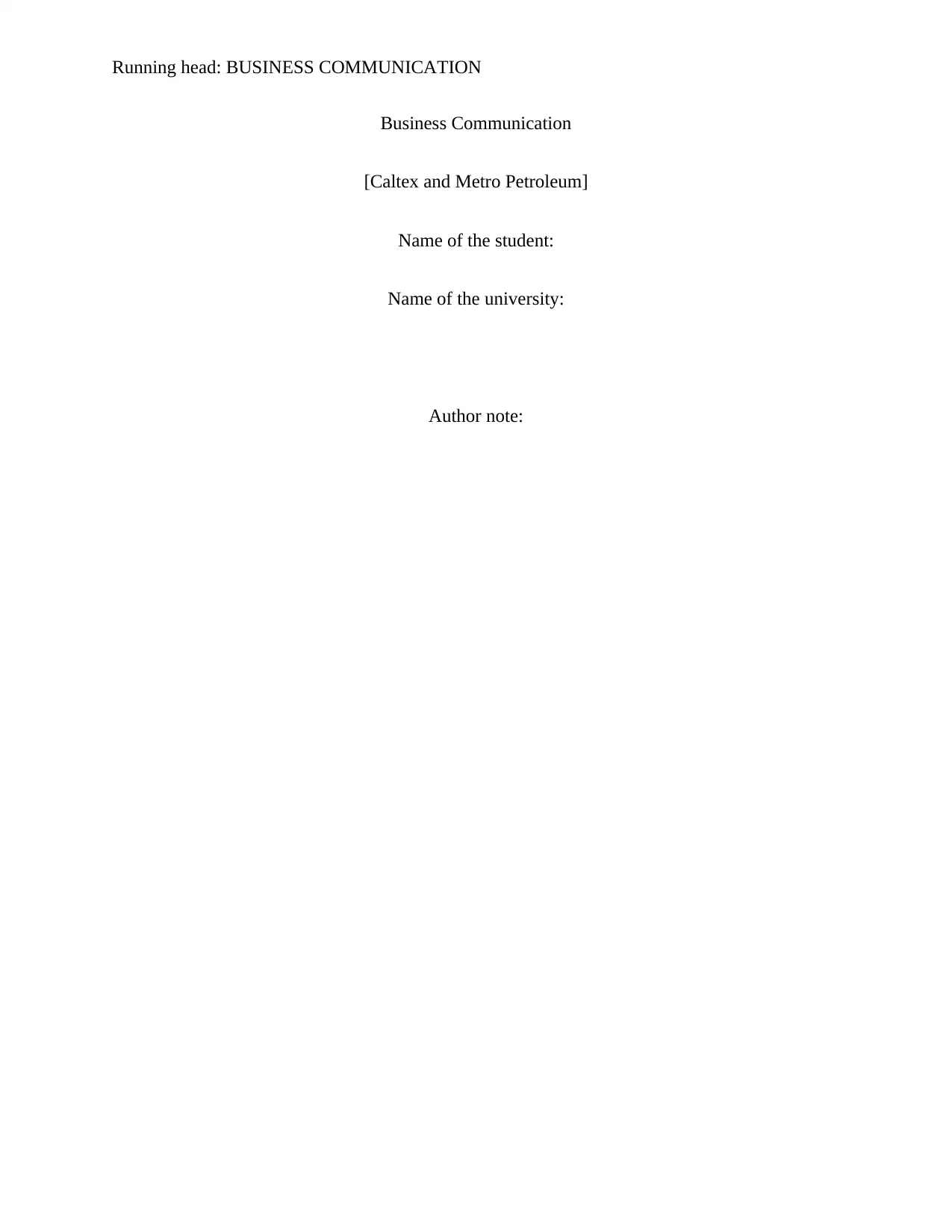
Running head: BUSINESS COMMUNICATION
Business Communication
[Caltex and Metro Petroleum]
Name of the student:
Name of the university:
Author note:
Business Communication
[Caltex and Metro Petroleum]
Name of the student:
Name of the university:
Author note:
Paraphrase This Document
Need a fresh take? Get an instant paraphrase of this document with our AI Paraphraser
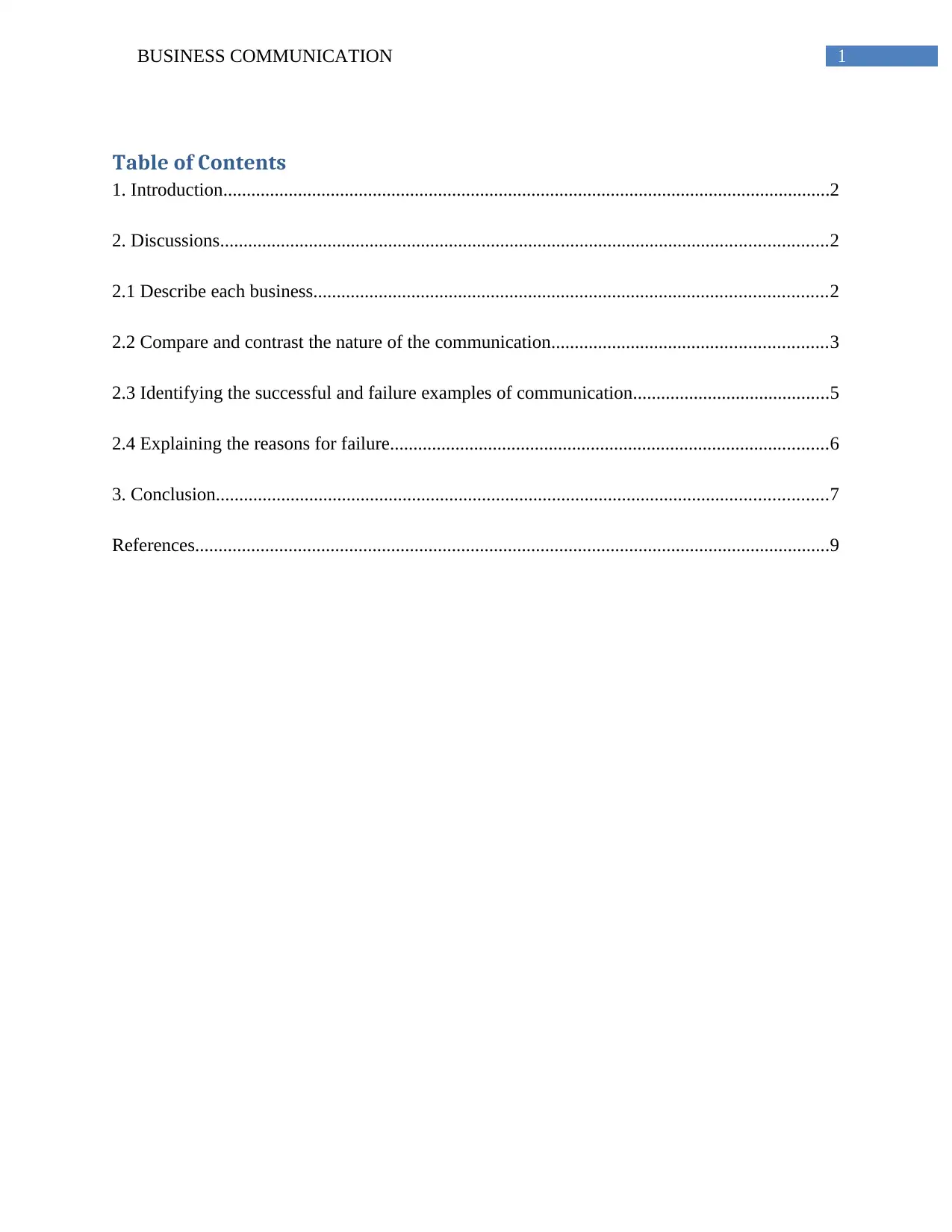
1BUSINESS COMMUNICATION
Table of Contents
1. Introduction..................................................................................................................................2
2. Discussions..................................................................................................................................2
2.1 Describe each business..............................................................................................................2
2.2 Compare and contrast the nature of the communication...........................................................3
2.3 Identifying the successful and failure examples of communication..........................................5
2.4 Explaining the reasons for failure..............................................................................................6
3. Conclusion...................................................................................................................................7
References........................................................................................................................................9
Table of Contents
1. Introduction..................................................................................................................................2
2. Discussions..................................................................................................................................2
2.1 Describe each business..............................................................................................................2
2.2 Compare and contrast the nature of the communication...........................................................3
2.3 Identifying the successful and failure examples of communication..........................................5
2.4 Explaining the reasons for failure..............................................................................................6
3. Conclusion...................................................................................................................................7
References........................................................................................................................................9
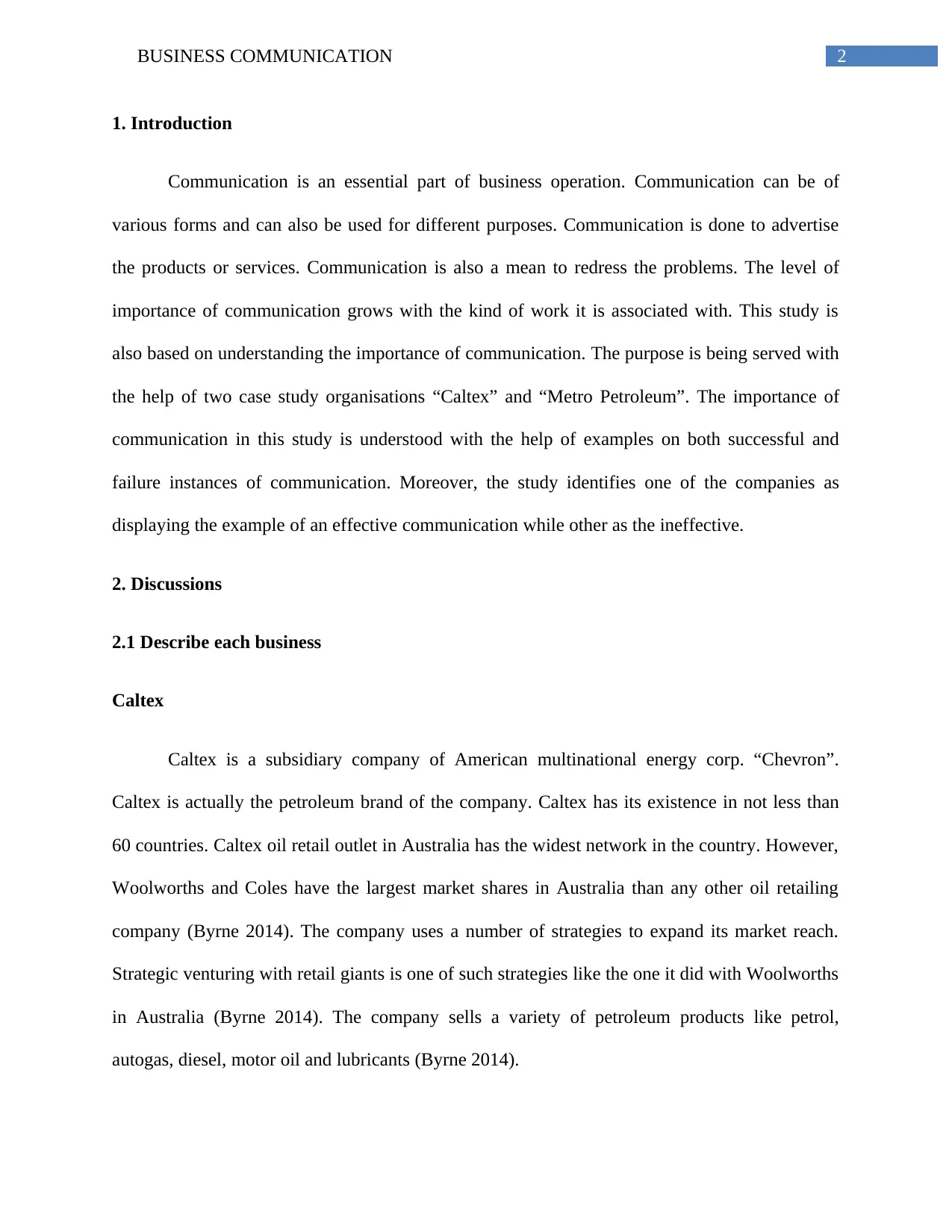
2BUSINESS COMMUNICATION
1. Introduction
Communication is an essential part of business operation. Communication can be of
various forms and can also be used for different purposes. Communication is done to advertise
the products or services. Communication is also a mean to redress the problems. The level of
importance of communication grows with the kind of work it is associated with. This study is
also based on understanding the importance of communication. The purpose is being served with
the help of two case study organisations “Caltex” and “Metro Petroleum”. The importance of
communication in this study is understood with the help of examples on both successful and
failure instances of communication. Moreover, the study identifies one of the companies as
displaying the example of an effective communication while other as the ineffective.
2. Discussions
2.1 Describe each business
Caltex
Caltex is a subsidiary company of American multinational energy corp. “Chevron”.
Caltex is actually the petroleum brand of the company. Caltex has its existence in not less than
60 countries. Caltex oil retail outlet in Australia has the widest network in the country. However,
Woolworths and Coles have the largest market shares in Australia than any other oil retailing
company (Byrne 2014). The company uses a number of strategies to expand its market reach.
Strategic venturing with retail giants is one of such strategies like the one it did with Woolworths
in Australia (Byrne 2014). The company sells a variety of petroleum products like petrol,
autogas, diesel, motor oil and lubricants (Byrne 2014).
1. Introduction
Communication is an essential part of business operation. Communication can be of
various forms and can also be used for different purposes. Communication is done to advertise
the products or services. Communication is also a mean to redress the problems. The level of
importance of communication grows with the kind of work it is associated with. This study is
also based on understanding the importance of communication. The purpose is being served with
the help of two case study organisations “Caltex” and “Metro Petroleum”. The importance of
communication in this study is understood with the help of examples on both successful and
failure instances of communication. Moreover, the study identifies one of the companies as
displaying the example of an effective communication while other as the ineffective.
2. Discussions
2.1 Describe each business
Caltex
Caltex is a subsidiary company of American multinational energy corp. “Chevron”.
Caltex is actually the petroleum brand of the company. Caltex has its existence in not less than
60 countries. Caltex oil retail outlet in Australia has the widest network in the country. However,
Woolworths and Coles have the largest market shares in Australia than any other oil retailing
company (Byrne 2014). The company uses a number of strategies to expand its market reach.
Strategic venturing with retail giants is one of such strategies like the one it did with Woolworths
in Australia (Byrne 2014). The company sells a variety of petroleum products like petrol,
autogas, diesel, motor oil and lubricants (Byrne 2014).
⊘ This is a preview!⊘
Do you want full access?
Subscribe today to unlock all pages.

Trusted by 1+ million students worldwide
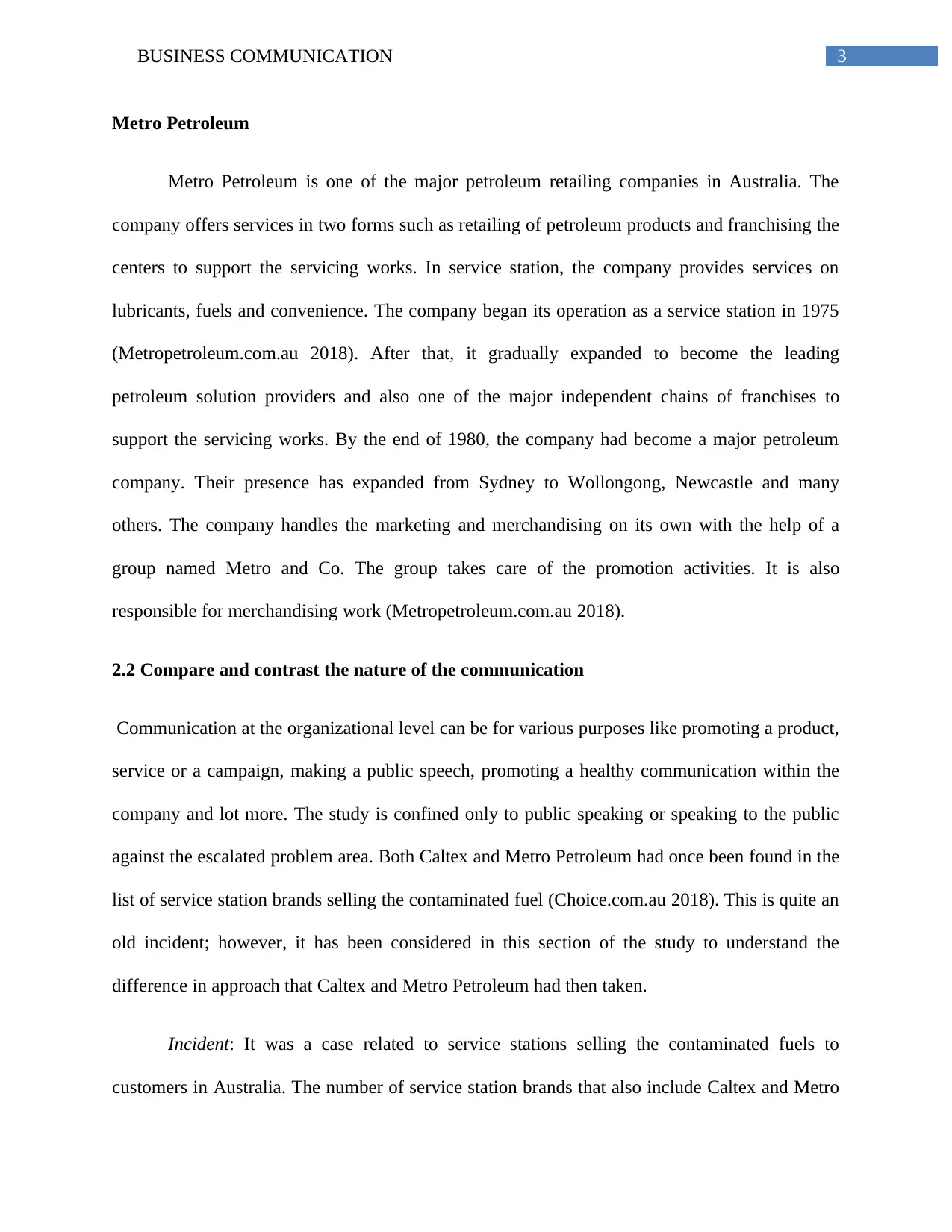
3BUSINESS COMMUNICATION
Metro Petroleum
Metro Petroleum is one of the major petroleum retailing companies in Australia. The
company offers services in two forms such as retailing of petroleum products and franchising the
centers to support the servicing works. In service station, the company provides services on
lubricants, fuels and convenience. The company began its operation as a service station in 1975
(Metropetroleum.com.au 2018). After that, it gradually expanded to become the leading
petroleum solution providers and also one of the major independent chains of franchises to
support the servicing works. By the end of 1980, the company had become a major petroleum
company. Their presence has expanded from Sydney to Wollongong, Newcastle and many
others. The company handles the marketing and merchandising on its own with the help of a
group named Metro and Co. The group takes care of the promotion activities. It is also
responsible for merchandising work (Metropetroleum.com.au 2018).
2.2 Compare and contrast the nature of the communication
Communication at the organizational level can be for various purposes like promoting a product,
service or a campaign, making a public speech, promoting a healthy communication within the
company and lot more. The study is confined only to public speaking or speaking to the public
against the escalated problem area. Both Caltex and Metro Petroleum had once been found in the
list of service station brands selling the contaminated fuel (Choice.com.au 2018). This is quite an
old incident; however, it has been considered in this section of the study to understand the
difference in approach that Caltex and Metro Petroleum had then taken.
Incident: It was a case related to service stations selling the contaminated fuels to
customers in Australia. The number of service station brands that also include Caltex and Metro
Metro Petroleum
Metro Petroleum is one of the major petroleum retailing companies in Australia. The
company offers services in two forms such as retailing of petroleum products and franchising the
centers to support the servicing works. In service station, the company provides services on
lubricants, fuels and convenience. The company began its operation as a service station in 1975
(Metropetroleum.com.au 2018). After that, it gradually expanded to become the leading
petroleum solution providers and also one of the major independent chains of franchises to
support the servicing works. By the end of 1980, the company had become a major petroleum
company. Their presence has expanded from Sydney to Wollongong, Newcastle and many
others. The company handles the marketing and merchandising on its own with the help of a
group named Metro and Co. The group takes care of the promotion activities. It is also
responsible for merchandising work (Metropetroleum.com.au 2018).
2.2 Compare and contrast the nature of the communication
Communication at the organizational level can be for various purposes like promoting a product,
service or a campaign, making a public speech, promoting a healthy communication within the
company and lot more. The study is confined only to public speaking or speaking to the public
against the escalated problem area. Both Caltex and Metro Petroleum had once been found in the
list of service station brands selling the contaminated fuel (Choice.com.au 2018). This is quite an
old incident; however, it has been considered in this section of the study to understand the
difference in approach that Caltex and Metro Petroleum had then taken.
Incident: It was a case related to service stations selling the contaminated fuels to
customers in Australia. The number of service station brands that also include Caltex and Metro
Paraphrase This Document
Need a fresh take? Get an instant paraphrase of this document with our AI Paraphraser
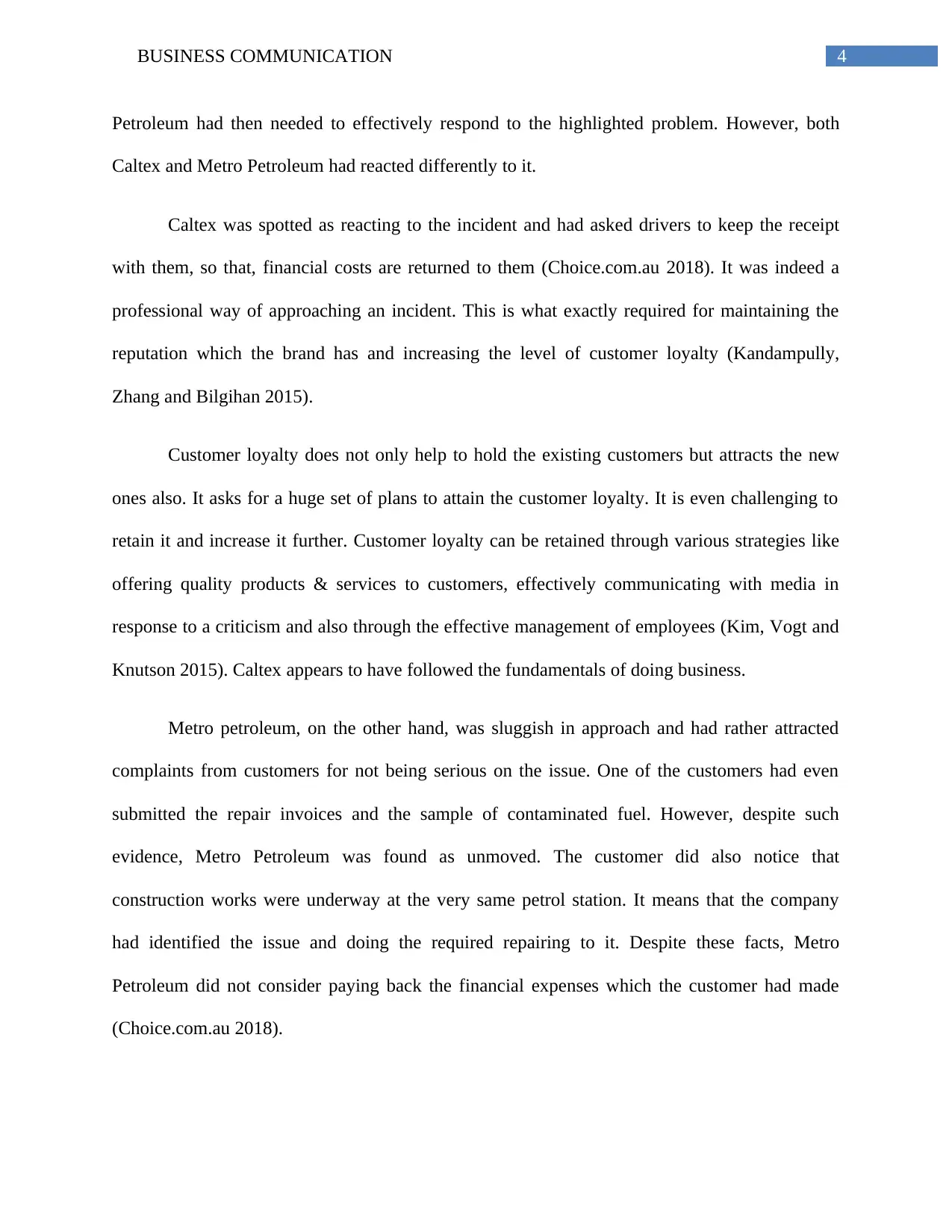
4BUSINESS COMMUNICATION
Petroleum had then needed to effectively respond to the highlighted problem. However, both
Caltex and Metro Petroleum had reacted differently to it.
Caltex was spotted as reacting to the incident and had asked drivers to keep the receipt
with them, so that, financial costs are returned to them (Choice.com.au 2018). It was indeed a
professional way of approaching an incident. This is what exactly required for maintaining the
reputation which the brand has and increasing the level of customer loyalty (Kandampully,
Zhang and Bilgihan 2015).
Customer loyalty does not only help to hold the existing customers but attracts the new
ones also. It asks for a huge set of plans to attain the customer loyalty. It is even challenging to
retain it and increase it further. Customer loyalty can be retained through various strategies like
offering quality products & services to customers, effectively communicating with media in
response to a criticism and also through the effective management of employees (Kim, Vogt and
Knutson 2015). Caltex appears to have followed the fundamentals of doing business.
Metro petroleum, on the other hand, was sluggish in approach and had rather attracted
complaints from customers for not being serious on the issue. One of the customers had even
submitted the repair invoices and the sample of contaminated fuel. However, despite such
evidence, Metro Petroleum was found as unmoved. The customer did also notice that
construction works were underway at the very same petrol station. It means that the company
had identified the issue and doing the required repairing to it. Despite these facts, Metro
Petroleum did not consider paying back the financial expenses which the customer had made
(Choice.com.au 2018).
Petroleum had then needed to effectively respond to the highlighted problem. However, both
Caltex and Metro Petroleum had reacted differently to it.
Caltex was spotted as reacting to the incident and had asked drivers to keep the receipt
with them, so that, financial costs are returned to them (Choice.com.au 2018). It was indeed a
professional way of approaching an incident. This is what exactly required for maintaining the
reputation which the brand has and increasing the level of customer loyalty (Kandampully,
Zhang and Bilgihan 2015).
Customer loyalty does not only help to hold the existing customers but attracts the new
ones also. It asks for a huge set of plans to attain the customer loyalty. It is even challenging to
retain it and increase it further. Customer loyalty can be retained through various strategies like
offering quality products & services to customers, effectively communicating with media in
response to a criticism and also through the effective management of employees (Kim, Vogt and
Knutson 2015). Caltex appears to have followed the fundamentals of doing business.
Metro petroleum, on the other hand, was sluggish in approach and had rather attracted
complaints from customers for not being serious on the issue. One of the customers had even
submitted the repair invoices and the sample of contaminated fuel. However, despite such
evidence, Metro Petroleum was found as unmoved. The customer did also notice that
construction works were underway at the very same petrol station. It means that the company
had identified the issue and doing the required repairing to it. Despite these facts, Metro
Petroleum did not consider paying back the financial expenses which the customer had made
(Choice.com.au 2018).
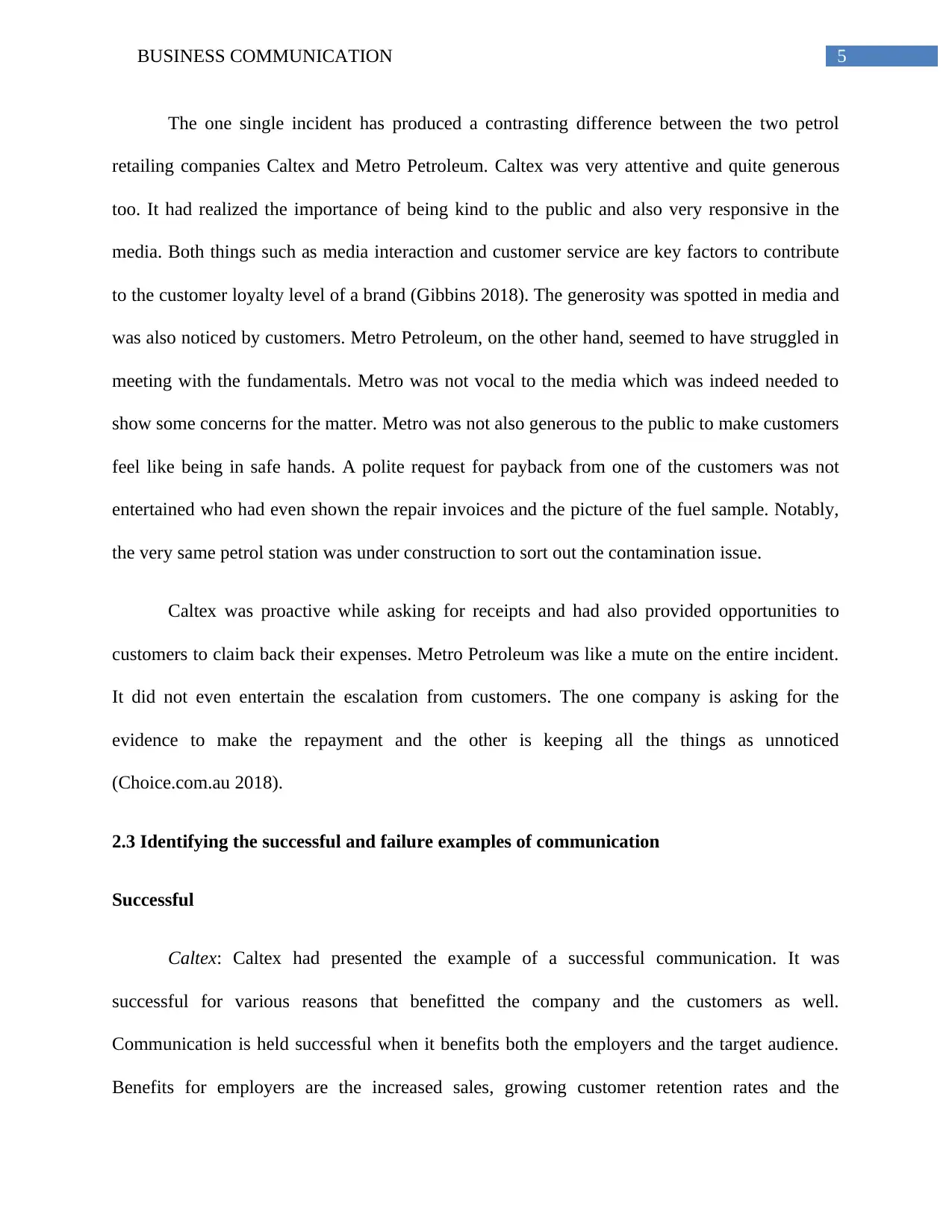
5BUSINESS COMMUNICATION
The one single incident has produced a contrasting difference between the two petrol
retailing companies Caltex and Metro Petroleum. Caltex was very attentive and quite generous
too. It had realized the importance of being kind to the public and also very responsive in the
media. Both things such as media interaction and customer service are key factors to contribute
to the customer loyalty level of a brand (Gibbins 2018). The generosity was spotted in media and
was also noticed by customers. Metro Petroleum, on the other hand, seemed to have struggled in
meeting with the fundamentals. Metro was not vocal to the media which was indeed needed to
show some concerns for the matter. Metro was not also generous to the public to make customers
feel like being in safe hands. A polite request for payback from one of the customers was not
entertained who had even shown the repair invoices and the picture of the fuel sample. Notably,
the very same petrol station was under construction to sort out the contamination issue.
Caltex was proactive while asking for receipts and had also provided opportunities to
customers to claim back their expenses. Metro Petroleum was like a mute on the entire incident.
It did not even entertain the escalation from customers. The one company is asking for the
evidence to make the repayment and the other is keeping all the things as unnoticed
(Choice.com.au 2018).
2.3 Identifying the successful and failure examples of communication
Successful
Caltex: Caltex had presented the example of a successful communication. It was
successful for various reasons that benefitted the company and the customers as well.
Communication is held successful when it benefits both the employers and the target audience.
Benefits for employers are the increased sales, growing customer retention rates and the
The one single incident has produced a contrasting difference between the two petrol
retailing companies Caltex and Metro Petroleum. Caltex was very attentive and quite generous
too. It had realized the importance of being kind to the public and also very responsive in the
media. Both things such as media interaction and customer service are key factors to contribute
to the customer loyalty level of a brand (Gibbins 2018). The generosity was spotted in media and
was also noticed by customers. Metro Petroleum, on the other hand, seemed to have struggled in
meeting with the fundamentals. Metro was not vocal to the media which was indeed needed to
show some concerns for the matter. Metro was not also generous to the public to make customers
feel like being in safe hands. A polite request for payback from one of the customers was not
entertained who had even shown the repair invoices and the picture of the fuel sample. Notably,
the very same petrol station was under construction to sort out the contamination issue.
Caltex was proactive while asking for receipts and had also provided opportunities to
customers to claim back their expenses. Metro Petroleum was like a mute on the entire incident.
It did not even entertain the escalation from customers. The one company is asking for the
evidence to make the repayment and the other is keeping all the things as unnoticed
(Choice.com.au 2018).
2.3 Identifying the successful and failure examples of communication
Successful
Caltex: Caltex had presented the example of a successful communication. It was
successful for various reasons that benefitted the company and the customers as well.
Communication is held successful when it benefits both the employers and the target audience.
Benefits for employers are the increased sales, growing customer retention rates and the
⊘ This is a preview!⊘
Do you want full access?
Subscribe today to unlock all pages.

Trusted by 1+ million students worldwide
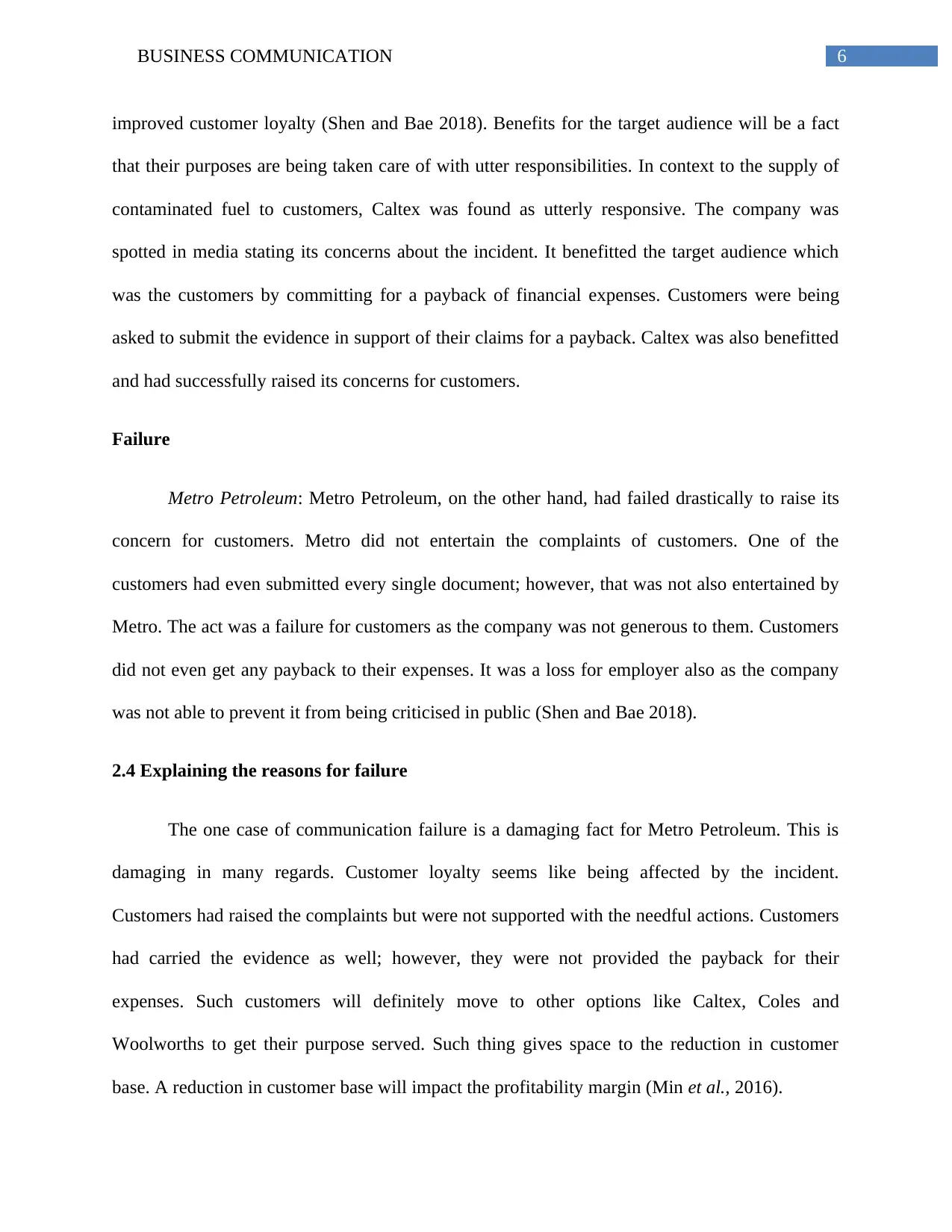
6BUSINESS COMMUNICATION
improved customer loyalty (Shen and Bae 2018). Benefits for the target audience will be a fact
that their purposes are being taken care of with utter responsibilities. In context to the supply of
contaminated fuel to customers, Caltex was found as utterly responsive. The company was
spotted in media stating its concerns about the incident. It benefitted the target audience which
was the customers by committing for a payback of financial expenses. Customers were being
asked to submit the evidence in support of their claims for a payback. Caltex was also benefitted
and had successfully raised its concerns for customers.
Failure
Metro Petroleum: Metro Petroleum, on the other hand, had failed drastically to raise its
concern for customers. Metro did not entertain the complaints of customers. One of the
customers had even submitted every single document; however, that was not also entertained by
Metro. The act was a failure for customers as the company was not generous to them. Customers
did not even get any payback to their expenses. It was a loss for employer also as the company
was not able to prevent it from being criticised in public (Shen and Bae 2018).
2.4 Explaining the reasons for failure
The one case of communication failure is a damaging fact for Metro Petroleum. This is
damaging in many regards. Customer loyalty seems like being affected by the incident.
Customers had raised the complaints but were not supported with the needful actions. Customers
had carried the evidence as well; however, they were not provided the payback for their
expenses. Such customers will definitely move to other options like Caltex, Coles and
Woolworths to get their purpose served. Such thing gives space to the reduction in customer
base. A reduction in customer base will impact the profitability margin (Min et al., 2016).
improved customer loyalty (Shen and Bae 2018). Benefits for the target audience will be a fact
that their purposes are being taken care of with utter responsibilities. In context to the supply of
contaminated fuel to customers, Caltex was found as utterly responsive. The company was
spotted in media stating its concerns about the incident. It benefitted the target audience which
was the customers by committing for a payback of financial expenses. Customers were being
asked to submit the evidence in support of their claims for a payback. Caltex was also benefitted
and had successfully raised its concerns for customers.
Failure
Metro Petroleum: Metro Petroleum, on the other hand, had failed drastically to raise its
concern for customers. Metro did not entertain the complaints of customers. One of the
customers had even submitted every single document; however, that was not also entertained by
Metro. The act was a failure for customers as the company was not generous to them. Customers
did not even get any payback to their expenses. It was a loss for employer also as the company
was not able to prevent it from being criticised in public (Shen and Bae 2018).
2.4 Explaining the reasons for failure
The one case of communication failure is a damaging fact for Metro Petroleum. This is
damaging in many regards. Customer loyalty seems like being affected by the incident.
Customers had raised the complaints but were not supported with the needful actions. Customers
had carried the evidence as well; however, they were not provided the payback for their
expenses. Such customers will definitely move to other options like Caltex, Coles and
Woolworths to get their purpose served. Such thing gives space to the reduction in customer
base. A reduction in customer base will impact the profitability margin (Min et al., 2016).
Paraphrase This Document
Need a fresh take? Get an instant paraphrase of this document with our AI Paraphraser
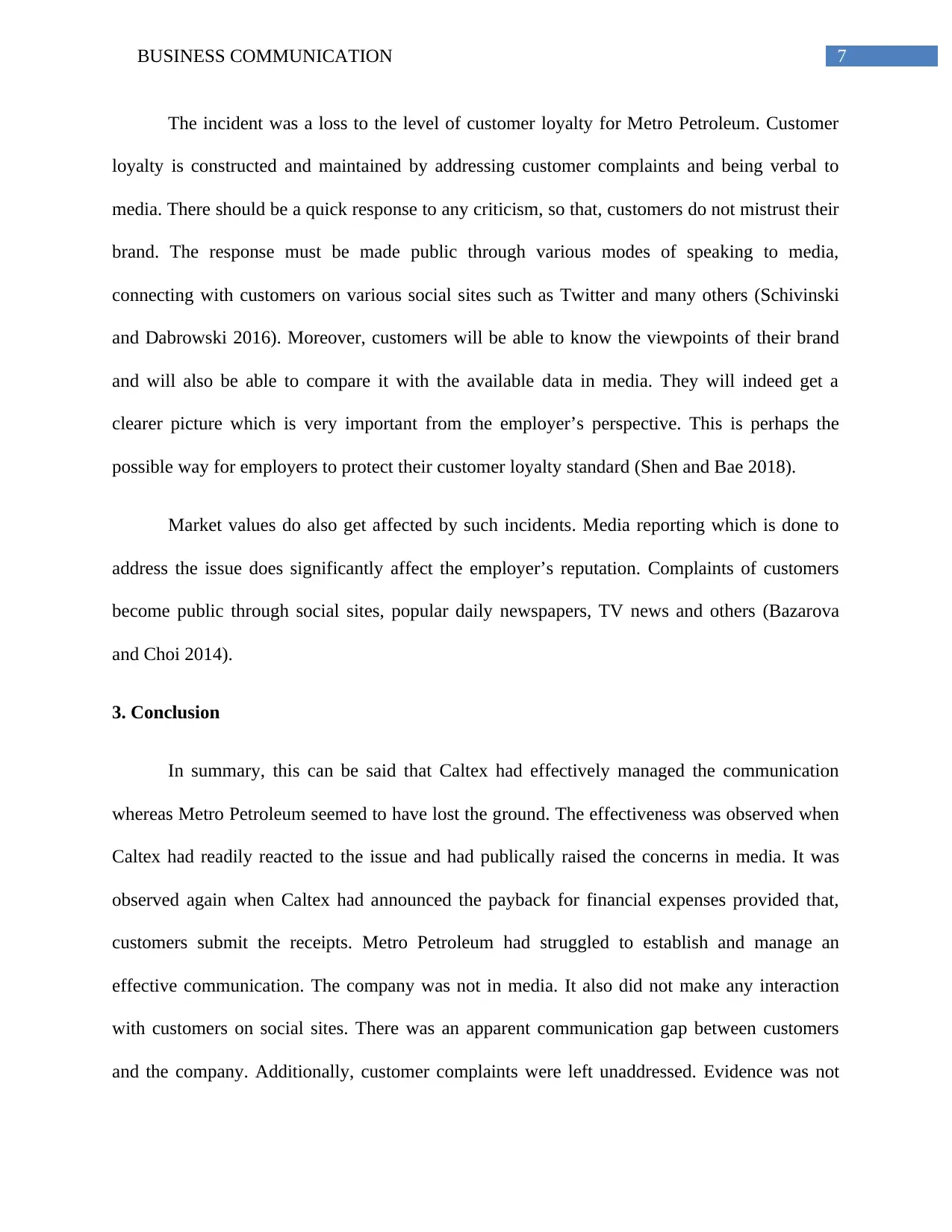
7BUSINESS COMMUNICATION
The incident was a loss to the level of customer loyalty for Metro Petroleum. Customer
loyalty is constructed and maintained by addressing customer complaints and being verbal to
media. There should be a quick response to any criticism, so that, customers do not mistrust their
brand. The response must be made public through various modes of speaking to media,
connecting with customers on various social sites such as Twitter and many others (Schivinski
and Dabrowski 2016). Moreover, customers will be able to know the viewpoints of their brand
and will also be able to compare it with the available data in media. They will indeed get a
clearer picture which is very important from the employer’s perspective. This is perhaps the
possible way for employers to protect their customer loyalty standard (Shen and Bae 2018).
Market values do also get affected by such incidents. Media reporting which is done to
address the issue does significantly affect the employer’s reputation. Complaints of customers
become public through social sites, popular daily newspapers, TV news and others (Bazarova
and Choi 2014).
3. Conclusion
In summary, this can be said that Caltex had effectively managed the communication
whereas Metro Petroleum seemed to have lost the ground. The effectiveness was observed when
Caltex had readily reacted to the issue and had publically raised the concerns in media. It was
observed again when Caltex had announced the payback for financial expenses provided that,
customers submit the receipts. Metro Petroleum had struggled to establish and manage an
effective communication. The company was not in media. It also did not make any interaction
with customers on social sites. There was an apparent communication gap between customers
and the company. Additionally, customer complaints were left unaddressed. Evidence was not
The incident was a loss to the level of customer loyalty for Metro Petroleum. Customer
loyalty is constructed and maintained by addressing customer complaints and being verbal to
media. There should be a quick response to any criticism, so that, customers do not mistrust their
brand. The response must be made public through various modes of speaking to media,
connecting with customers on various social sites such as Twitter and many others (Schivinski
and Dabrowski 2016). Moreover, customers will be able to know the viewpoints of their brand
and will also be able to compare it with the available data in media. They will indeed get a
clearer picture which is very important from the employer’s perspective. This is perhaps the
possible way for employers to protect their customer loyalty standard (Shen and Bae 2018).
Market values do also get affected by such incidents. Media reporting which is done to
address the issue does significantly affect the employer’s reputation. Complaints of customers
become public through social sites, popular daily newspapers, TV news and others (Bazarova
and Choi 2014).
3. Conclusion
In summary, this can be said that Caltex had effectively managed the communication
whereas Metro Petroleum seemed to have lost the ground. The effectiveness was observed when
Caltex had readily reacted to the issue and had publically raised the concerns in media. It was
observed again when Caltex had announced the payback for financial expenses provided that,
customers submit the receipts. Metro Petroleum had struggled to establish and manage an
effective communication. The company was not in media. It also did not make any interaction
with customers on social sites. There was an apparent communication gap between customers
and the company. Additionally, customer complaints were left unaddressed. Evidence was not
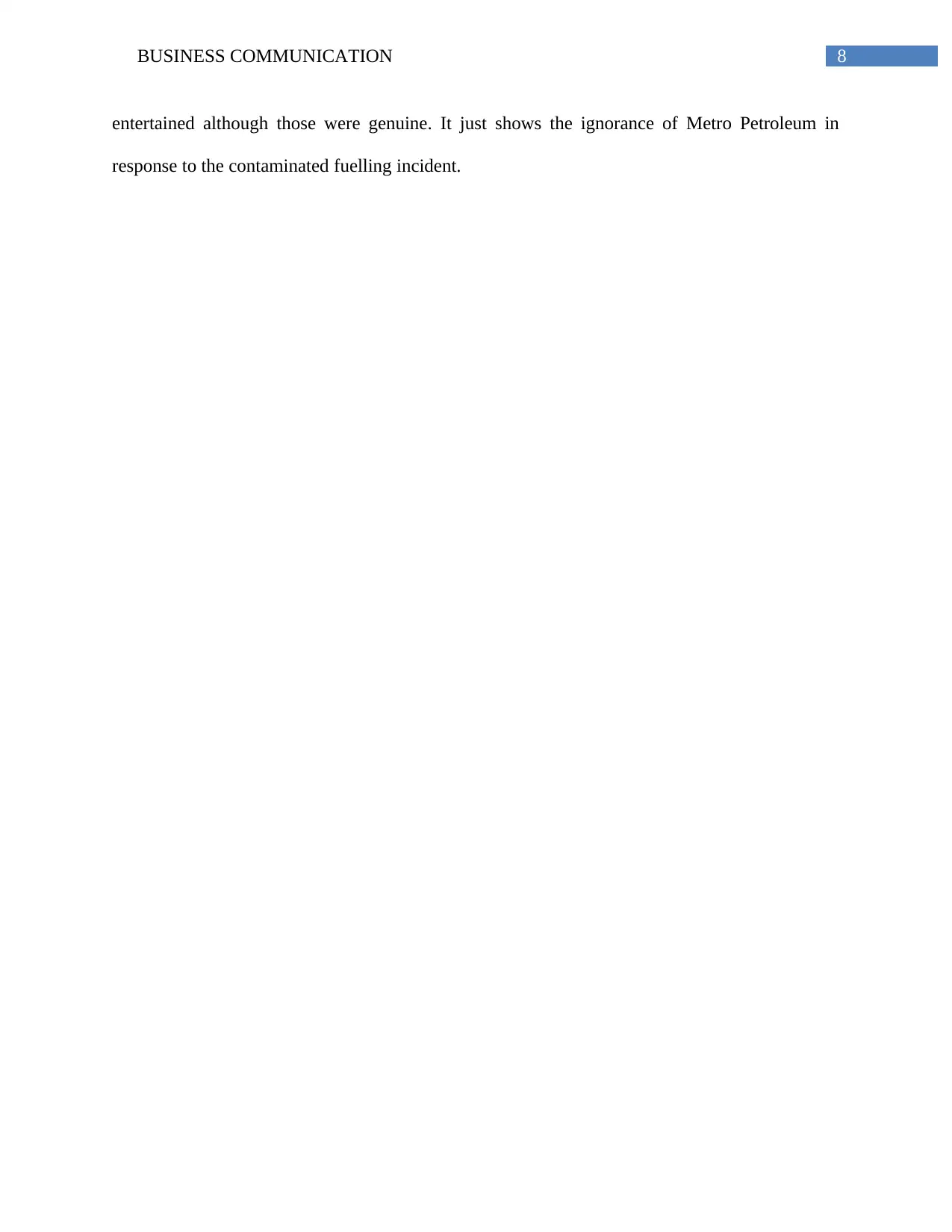
8BUSINESS COMMUNICATION
entertained although those were genuine. It just shows the ignorance of Metro Petroleum in
response to the contaminated fuelling incident.
entertained although those were genuine. It just shows the ignorance of Metro Petroleum in
response to the contaminated fuelling incident.
⊘ This is a preview!⊘
Do you want full access?
Subscribe today to unlock all pages.

Trusted by 1+ million students worldwide
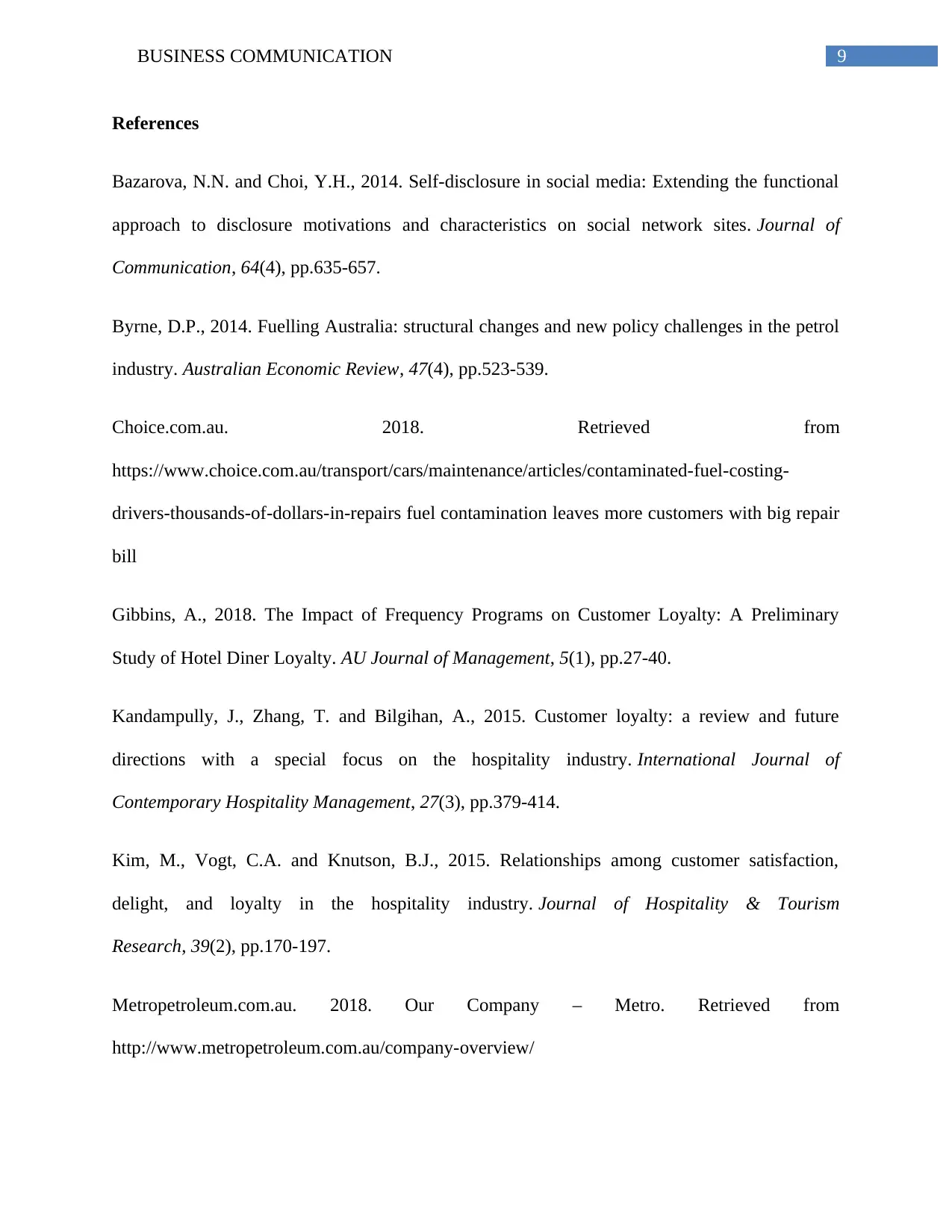
9BUSINESS COMMUNICATION
References
Bazarova, N.N. and Choi, Y.H., 2014. Self-disclosure in social media: Extending the functional
approach to disclosure motivations and characteristics on social network sites. Journal of
Communication, 64(4), pp.635-657.
Byrne, D.P., 2014. Fuelling Australia: structural changes and new policy challenges in the petrol
industry. Australian Economic Review, 47(4), pp.523-539.
Choice.com.au. 2018. Retrieved from
https://www.choice.com.au/transport/cars/maintenance/articles/contaminated-fuel-costing-
drivers-thousands-of-dollars-in-repairs fuel contamination leaves more customers with big repair
bill
Gibbins, A., 2018. The Impact of Frequency Programs on Customer Loyalty: A Preliminary
Study of Hotel Diner Loyalty. AU Journal of Management, 5(1), pp.27-40.
Kandampully, J., Zhang, T. and Bilgihan, A., 2015. Customer loyalty: a review and future
directions with a special focus on the hospitality industry. International Journal of
Contemporary Hospitality Management, 27(3), pp.379-414.
Kim, M., Vogt, C.A. and Knutson, B.J., 2015. Relationships among customer satisfaction,
delight, and loyalty in the hospitality industry. Journal of Hospitality & Tourism
Research, 39(2), pp.170-197.
Metropetroleum.com.au. 2018. Our Company – Metro. Retrieved from
http://www.metropetroleum.com.au/company-overview/
References
Bazarova, N.N. and Choi, Y.H., 2014. Self-disclosure in social media: Extending the functional
approach to disclosure motivations and characteristics on social network sites. Journal of
Communication, 64(4), pp.635-657.
Byrne, D.P., 2014. Fuelling Australia: structural changes and new policy challenges in the petrol
industry. Australian Economic Review, 47(4), pp.523-539.
Choice.com.au. 2018. Retrieved from
https://www.choice.com.au/transport/cars/maintenance/articles/contaminated-fuel-costing-
drivers-thousands-of-dollars-in-repairs fuel contamination leaves more customers with big repair
bill
Gibbins, A., 2018. The Impact of Frequency Programs on Customer Loyalty: A Preliminary
Study of Hotel Diner Loyalty. AU Journal of Management, 5(1), pp.27-40.
Kandampully, J., Zhang, T. and Bilgihan, A., 2015. Customer loyalty: a review and future
directions with a special focus on the hospitality industry. International Journal of
Contemporary Hospitality Management, 27(3), pp.379-414.
Kim, M., Vogt, C.A. and Knutson, B.J., 2015. Relationships among customer satisfaction,
delight, and loyalty in the hospitality industry. Journal of Hospitality & Tourism
Research, 39(2), pp.170-197.
Metropetroleum.com.au. 2018. Our Company – Metro. Retrieved from
http://www.metropetroleum.com.au/company-overview/
Paraphrase This Document
Need a fresh take? Get an instant paraphrase of this document with our AI Paraphraser
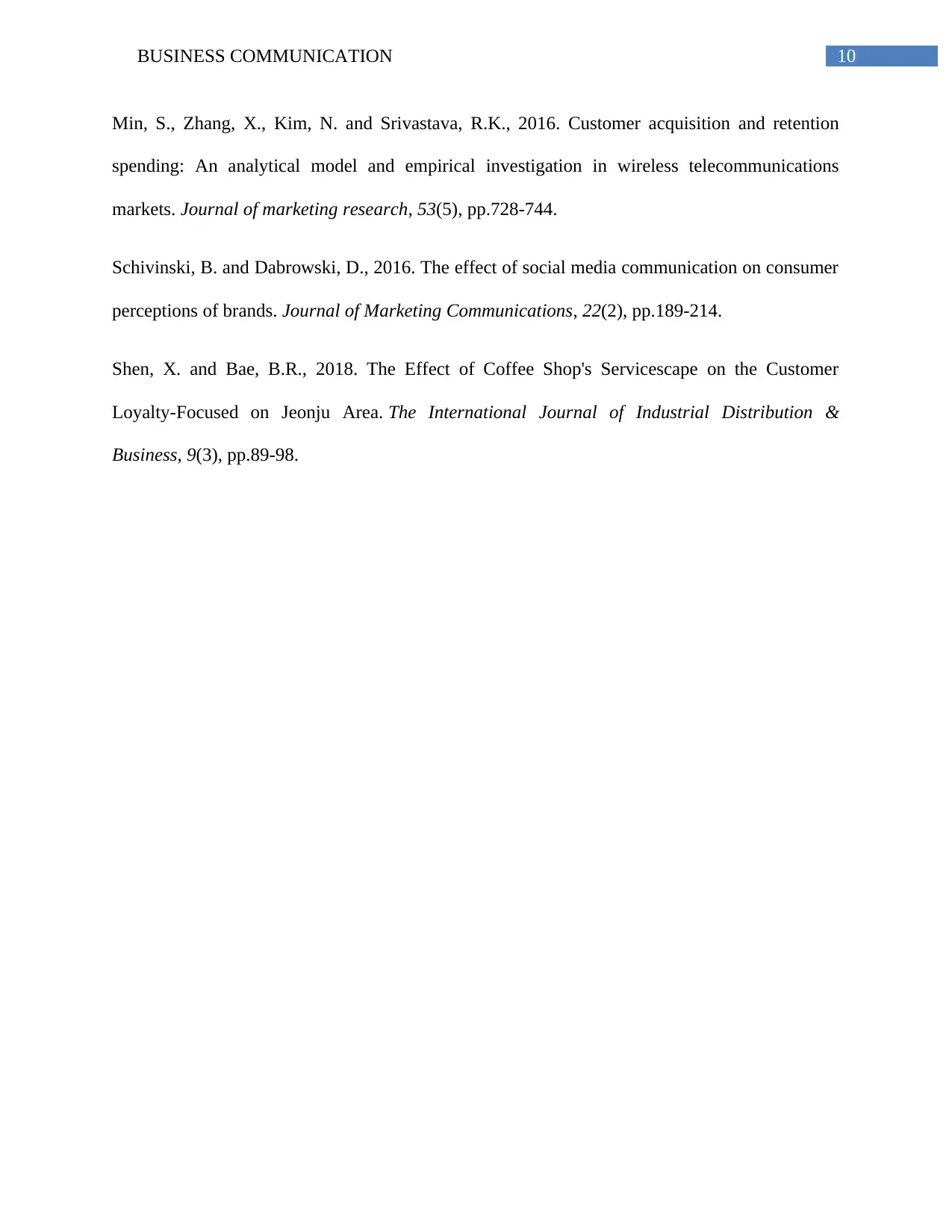
10BUSINESS COMMUNICATION
Min, S., Zhang, X., Kim, N. and Srivastava, R.K., 2016. Customer acquisition and retention
spending: An analytical model and empirical investigation in wireless telecommunications
markets. Journal of marketing research, 53(5), pp.728-744.
Schivinski, B. and Dabrowski, D., 2016. The effect of social media communication on consumer
perceptions of brands. Journal of Marketing Communications, 22(2), pp.189-214.
Shen, X. and Bae, B.R., 2018. The Effect of Coffee Shop's Servicescape on the Customer
Loyalty-Focused on Jeonju Area. The International Journal of Industrial Distribution &
Business, 9(3), pp.89-98.
Min, S., Zhang, X., Kim, N. and Srivastava, R.K., 2016. Customer acquisition and retention
spending: An analytical model and empirical investigation in wireless telecommunications
markets. Journal of marketing research, 53(5), pp.728-744.
Schivinski, B. and Dabrowski, D., 2016. The effect of social media communication on consumer
perceptions of brands. Journal of Marketing Communications, 22(2), pp.189-214.
Shen, X. and Bae, B.R., 2018. The Effect of Coffee Shop's Servicescape on the Customer
Loyalty-Focused on Jeonju Area. The International Journal of Industrial Distribution &
Business, 9(3), pp.89-98.
1 out of 11
Related Documents
Your All-in-One AI-Powered Toolkit for Academic Success.
+13062052269
info@desklib.com
Available 24*7 on WhatsApp / Email
![[object Object]](/_next/static/media/star-bottom.7253800d.svg)
Unlock your academic potential
Copyright © 2020–2025 A2Z Services. All Rights Reserved. Developed and managed by ZUCOL.





